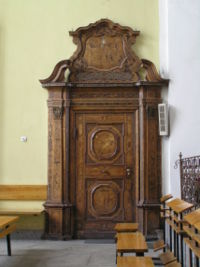
Overdoor
Encyclopedia

Molding (decorative)
Molding or moulding is a strip of material with various profiles used to cover transitions between surfaces or for decoration. It is traditionally made from solid milled wood or plaster but may be made from plastic or reformed wood...
, over a door, or was originally intended for this purpose.
The overdoor is usually architectural in form, but may take the form of a cartouche
Cartouche (design)
A cartouche is an oval or oblong design with a slightly convex surface, typically edged with ornamental scrollwork. It is used to hold a painted or low relief design....
in Rococo settings, or it may be little more than a moulded shelf for the placement of ceramic vases, busts or curiosities. An overmantel serves a similar function above a fireplace mantel
Fireplace mantel
Fireplace mantel or mantelpiece, also known as a chimneypiece, originated in medieval times as a hood that projected over a grate to catch the smoke. The term has evolved to include the decorative framework around the fireplace, and can include elaborate designs extending to the ceiling...
.
From the end of the sixeenth century, at first in interiors such as the Palazzo Sampieri, Bologna, where Annibale Carracci
Annibale Carracci
Annibale Carracci was an Italian Baroque painter.-Early career:Annibale Carracci was born in Bologna, and in all likelihood first apprenticed within his family...
provided overdoor paintings, they developed into a minor genre
Genre
Genre , Greek: genos, γένος) is the term for any category of literature or other forms of art or culture, e.g. music, and in general, any type of discourse, whether written or spoken, audial or visual, based on some set of stylistic criteria. Genres are formed by conventions that change over time...
of their own, in which the trompe l'oeil
Trompe l'oeil
Trompe-l'œil, which can also be spelled without the hyphen in English as trompe l'oeil, is an art technique involving extremely realistic imagery in order to create the optical illusion that the depicted objects appear in three dimensions.-History in painting:Although the phrase has its origin in...
representations of stone bas-reliefs, or vases of flowers, in which Jean-Baptiste Monnoyer
Jean-Baptiste Monnoyer
Jean-Baptiste Monnoyer was a Franco-Flemish painter who specialised in flower pieces. He was attached to the Gobelins tapestry workshops and the Beauvais tapestry workshops, too, where he produced cartoons of fruit and flowers for the tapestry-weavers, and at Beauvais was one of three painterswho...
specialized, were heightened by sotto in su perspective, in which the light was often painted to reproduce the light, diffused from below, that was entering the room from its windows. Overdoors of such flower pieces, allegorical subjects, and landscapes were favoured through the end of the eighteenth century. French, Dutch and Flemish animalier
Animalier
An animalier is an artist, mainly from the 19th century, who specializes in, or is known for, skill in the realistic portrayal of animals. "Animal painter" is the more general term for earlier artists...
artists such as Jean-Baptiste Oudry
Jean-Baptiste Oudry
Jean-Baptiste Oudry was a French Rococo painter, engraver, and tapestry designer. He is particularly well known for his naturalistic pictures of animals and his hunt pieces depicting game.-Biography:...
and Jan Weenix
Jan Weenix
Jan Weenix or Joannis Wenix was a Dutch painter. He was trained by his father, Jan Baptist Weenix, together with his cousin Melchior d'Hondecoeter. Like his father, he devoted himself to a variety of subjects, but his fame is chiefly due to his paintings of dead game and of hunting scenes...
were often commissioned to paint sets of overdoors with groups of live or dead game and dogs for country houses or hunting lodges.

